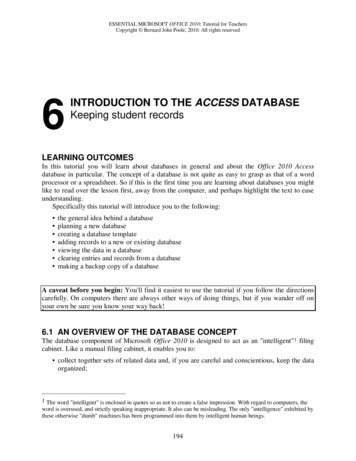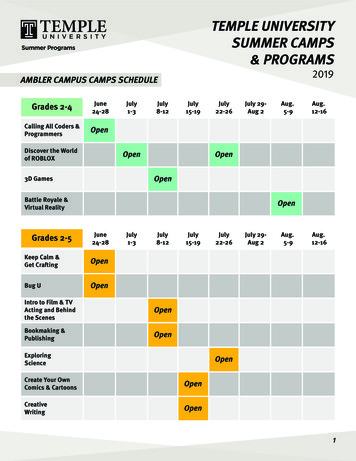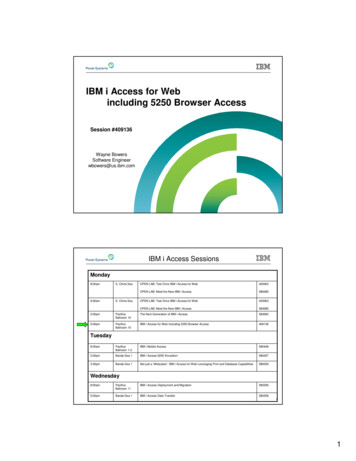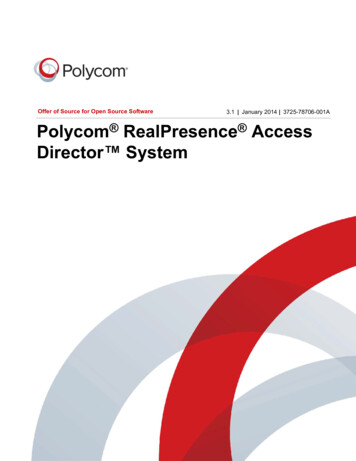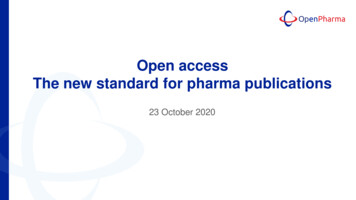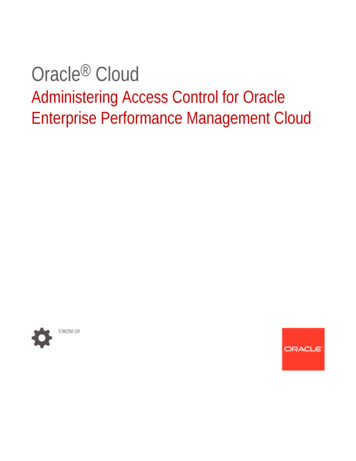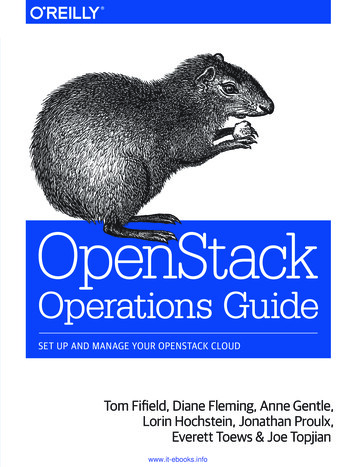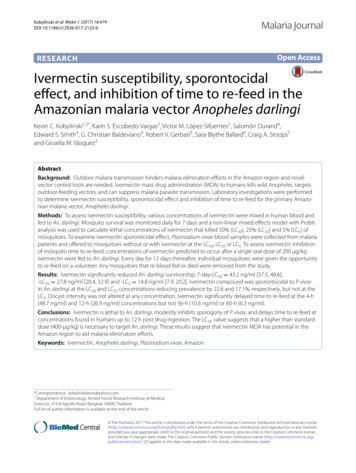
Transcription
Malaria JournalKobylinski et al. Malar J (2017) 16:474DOI 10.1186/s12936-017-2125-0Open AccessRESEARCHIvermectin susceptibility, sporontocidaleffect, and inhibition of time to re‑feed in theAmazonian malaria vector Anopheles darlingiKevin C. Kobylinski1,2*, Karín S. Escobedo‑Vargas3, Victor M. López‑Sifuentes3, Salomón Durand4,Edward S. Smith4, G. Christian Baldeviano4, Robert V. Gerbasi5, Sara‑Blythe Ballard6, Craig A. Stoops3and Gissella M. Vásquez3AbstractBackground: Outdoor malaria transmission hinders malaria elimination efforts in the Amazon region and novelvector control tools are needed. Ivermectin mass drug administration (MDA) to humans kills wild Anopheles, targetsoutdoor-feeding vectors, and can suppress malaria parasite transmission. Laboratory investigations were performedto determine ivermectin susceptibility, sporontocidal effect and inhibition of time to re-feed for the primary Amazo‑nian malaria vector, Anopheles darlingi.Methods: To assess ivermectin susceptibility, various concentrations of ivermectin were mixed in human blood andfed to An. darlingi. Mosquito survival was monitored daily for 7 days and a non-linear mixed effects model with Probitanalysis was used to calculate lethal concentrations of ivermectin that killed 50% ( LC50), 25% (LC25) and 5% (LC5) ofmosquitoes. To examine ivermectin sporonticidal effect, Plasmodium vivax blood samples were collected from malariapatients and offered to mosquitoes without or with ivermectin at the L C50, LC25 or LC5. To assess ivermectin inhibitionof mosquito time to re-feed, concentrations of ivermectin predicted to occur after a single oral dose of 200 μg/kgivermectin were fed to An. darlingi. Every day for 12 days thereafter, individual mosquitoes were given the opportunityto re-feed on a volunteer. Any mosquitoes that re-blood fed or died were removed from the study.Results: Ivermectin significantly reduced An. darlingi survivorship: 7-day-LC50 43.2 ng/ml [37.5, 48.6],-LC25 27.8 ng/ml [20.4, 32.9] and -LC5 14.8 ng/ml [7.9, 20.2]. Ivermectin compound was sporontocidal to P. vivaxin An. darlingi at the LC50 and LC25 concentrations reducing prevalence by 22.6 and 17.1%, respectively, but not at the LC5. Oocyst intensity was not altered at any concentration. Ivermectin significantly delayed time to re-feed at the 4-h(48.7 ng/ml) and 12-h (26.9 ng/ml) concentrations but not 36-h (10.6 ng/ml) or 60-h (6.3 ng/ml).Conclusions: Ivermectin is lethal to An. darlingi, modestly inhibits sporogony of P. vivax, and delays time to re-feed atconcentrations found in humans up to 12 h post drug ingestion. The LC50 value suggests that a higher than standarddose (400-μg/kg) is necessary to target An. darlingi. These results suggest that ivermectin MDA has potential in theAmazon region to aid malaria elimination efforts.Keywords: Ivermectin, Anopheles darlingi, Plasmodium vivax, Amazon*Correspondence: kobylinskikevin@yahoo.com1Department of Entomology, Armed Forces Research Institute of MedicalSciences, 315/6 Rajvithi Road, Bangkok 10400, ThailandFull list of author information is available at the end of the article The Author(s) 2017. This article is distributed under the terms of the Creative Commons Attribution 4.0 International /), which permits unrestricted use, distribution, and reproduction in any medium,provided you give appropriate credit to the original author(s) and the source, provide a link to the Creative Commons license,and indicate if changes were made. The Creative Commons Public Domain Dedication waiver ) applies to the data made available in this article, unless otherwise stated.
Kobylinski et al. Malar J (2017) 16:474BackgroundMalaria incidence is declining globally and rates are fallingin South America. Increased malaria control measures andaccess to effective artemisinin combination therapy for Plasmodium falciparum are attributed to this reduction, withPlasmodium vivax now being more prevalent than P. falciparum in the Americas, including the Amazon region [1, 2].Anopheles darlingi is considered the primary malaria vectorin the Amazon region [3]. Vector control is complicated bythe exophagic and exophilic tendencies of An. darlingi combined with the fact that it typically occurs in recently clearedareas of the jungle where people may have limited access tovector control measures and health care [4–8]. Therefore,developing novel vector control strategies which can targetexophagic and exophilic malaria vectors such as An. darlingiis essential to malaria elimination efforts in South America.Numerous laboratory studies [9, 10], animal studies, andclinical trials [11, 12] have demonstrated that ivermectinis lethal to more than a dozen species of Anopheles worldwide. Ivermectin mass drug administration (MDA) hasbeen suggested as a possible malaria parasite transmissioncontrol tool as it directly targets the vector at the pointof human blood feeding, making it one of the few vectorcontrol tools under investigation that can directly targetoutdoor malaria transmission. Ivermectin MDAs in WestAfrica [13, 14] and the South Pacific [15, 16] validated thativermectin is lethal to wild Anopheles at human-relevantconcentrations. Furthermore, the ivermectin MDAs inSenegal, Liberia and Burkina Faso demonstrated that ivermectin can suppress P. falciparum transmission by wildAnopheles gambiae s.l. [14, 17]. In addition to mosquitolethal effects, ivermectin at mosquito-sub-lethal concentrations affects additional parameters of vectorial capacityby inhibiting Plasmodium development in the vector [9,18, 19] and delaying mosquito time to re-feed [20].Ivermectin MDA campaigns have been performed inCentral and South America for onchocerciasis eliminationefforts by the Onchocerciasis Elimination Programme forthe Americas (OEPA). These MDAs have been very effective at reducing Onchocerca volvulus transmission andhave now eliminated the parasite from 11 of the 13 originalfoci [21–25]. Initially ivermectin MDAs for onchocerciasiswere performed once or twice per year in Latin America.Later, it was determined that ivermectin could be givensafely every 3 months [26] with quarterly MDAs effectivelyreducing transmission burden when nearing elimination[27]. Policy was changed and ivermectin MDAs have beendeployed up to four times annually at various onchocerciasis elimination foci in Latin America [21]. This illustratesthat frequent ivermectin MDAs with effective populationcoverage can be orchestrated in Latin America, and suggests that the more frequent ivermectin MDAs required tosuppress malaria transmission [28] could be possible.Page 2 of 9Before ivermectin MDAs for malaria parasite transmission suppression can be implemented in Latin America,the effects of ivermectin on key malaria vectors in theregion, such as An. darlingi, must be evaluated. Laboratory studies were conducted to investigate the effect ofivermectin compound on An. darlingi survivorship, P.vivax development in An. darlingi and whether ivermectin delays the An. darlingi time to re-feed.MethodsMosquitoesAll An. darlingi were reared at the Naval Medical ResearchUnit No. 6 (NAMRU-6) in Iquitos, Peru as described previously [29]. Larvae were raised in the larvae insectary room(26.8 0.7 C and 76.1 6.3% relative humidity, and 12-hlight:12-h dark photoperiod) and adults were maintainedin the adult insectary room (25.9 0.8 C and 69.7 5.7%relative humidity, and 12-h light:12-h dark photoperiod).Adult mosquitoes used for experiments were providedwith 10% sucrose solution ad libitum. Mosquitoes used forexperiments were between 3 and 5 days post emergenceand mosquitoes were sugar starved with access to waterfrom 18 to 22 h prior to their first blood meal.DrugIvermectin was prepared as described previously [9].Powdered formulation of ivermectin compound wasobtained from Sigma-Aldrich (St. Louis, MO, USA). Ivermectin was dissolved in dimethylsulfoxide (DMSO) toconcentrations of 10 mg/ml and 20 µl aliquots were frozen at – 20 C. Ivermectin was thawed and serial dilutionswere made in phosphate buffered saline (PBS) and 10 μlwas added to 990 μl of blood to reach final concentrationdesired for mosquito membrane-feeding assays. Control blood meals consisted of previously frozen DMSOdiluted in PBS to match the ratio of DMSO and PBS fedto mosquitoes in the ivermectin-containing blood meals.BloodChicken blood to maintain the mosquito colonies wasobtained from a local slaughter-house consistent with previous studies [29]. Blood for lethal concentration calculation experiments were drawn from healthy volunteers andmalaria-infected patients into 10 ml sodium heparin tubes(NH) (158 USP units, BD Vacutainer, Franklin Lakes, NJ,USA). Blood for lethal concentration experiments wasstored at 4 C and never more than 2 weeks post collectionat the time of mosquito blood feeds. Plasmodium vivaxinfected patients were identified by microscopic examination of Giemsa-stained thick blood smears at Ministryof Health health centres and hospitals in Iquitos. Patientswere transported to NAMRU-6, enrolled and venous blood(15-ml) was drawn on site for the ivermectin sporogony
Kobylinski et al. Malar J (2017) 16:474experiments following procedures approved by NAMRU-6and Walter Reed Army Institute of Research InstitutionalReview Boards (NMRCD.2008.0004 and WRAIR#2175)in compliance with all applicable Federal regulations governing the protection of human subjects. Blood for theivermectin re-feeding experiments was collected fromfour healthy, non-malarious volunteers, as determined bymicroscopy and confirmed by a pre-optimized nested PCRassay [30, 31] (NAMRU6.2014.0009 and WRAIR#2342).Ivermectin lethal concentration calculationsLethal concentration calculations for An. darlingi wereperformed as described previously [9]. Anopheles darlingiwere blood fed multiple concentrations of ivermectin todetermine the lethal concentration that killed 50% ( LC50),25% (LC25) and 5% ( LC5) of the mosquitoes following previous methods [18, 20]. Control blood meals consisted ofDMSO diluted in PBS to match the concentration foundin the highest ivermectin treatment group in each replicate. After blood feeding via a membrane feeder, blood-fedmosquitoes were gently aspirated from the feeding container and transferred to clean, 250-ml, cardboard containers with access to 10% sucrose and kept in the infectioninsectary room at 24.8 1.0 C and 62.1 6.7% relativehumidity, on a 12-h light:12-h dark photoperiod. Mosquitosurvivorship was monitored for 7 days, every 24 h deadmosquitoes were removed and recorded and on day 7 allremaining mosquitoes were frozen and counted as alive.Page 3 of 9from the healthy volunteers and mixed with the four ivermectin concentrations and a DMSO control matched tothe highest ivermectin concentration. One ml of blood foreach concentration was offered to 100 An. darlingi femalesvia a membrane feeder. Twenty fully engorged femalesfrom each concentration were individually transferred toseparate 50-ml conical tubes. Each tube had cotton padding and filter paper placed on the bottom of the tubeand moistened with 5 ml of distilled water, and the top ofthe tube was sealed with mesh netting. Mosquitoes weremaintained in the adult insectary room and held withoutaccess to sugar for the remainder of the experiment. Every24 h the volunteers returned to NAMRU-6 to re-feed themosquitoes. Volunteers laid their forearms across the topsof the 50-ml tubes for 5 min. Care was taken to ensure thatvolunteers blood fed only the mosquitoes that ingestedtheir original blood samples. Once all the mosquitoes hadbeen given the opportunity to re-feed they were investigated visually for blood meal ingestion or death by shining a bright headlamp onto the mosquito. Any blood fedor dead mosquitoes were removed from the experimentand recorded. Volunteers returned to NAMRU-6 for 12consecutive days for mosquito re-feeding opportunities.Any mosquitoes alive at the end of the experiment wererecorded (NAMRU6.2014.0009 and WRAIR#2342).Statistical analysisPlasmodium vivax-infected blood was collected frommalaria-infected patients as described above. Ivermectinat LC50, LC25 and LC5 concentrations and pair-matchedDMSO controls were added to 1 ml of whole blood andan additional 1 ml of whole blood without ivermectin orDMSO control were fed to approximately 100 An. darlingi per 2.5-l plastic container. Unfed mosquitoes wereremoved from the container and discarded. Blood-fedmosquitoes were left in the container and provided with10% sucrose solution. Mosquitoes infected with P. vivaxwere securely maintained in the infection insectary room.Mosquitoes were dissected 7 days post parasite ingestion to enumerate oocysts. Midguts were dissected withminuten pins into saline on a microscope slide and stainedwith 0.1% mercurochrome and viewed at 40 magnification with a compound microscope to determine oocystprevalence and intensity. Approximately 25 mosquitoeswere dissected from each control and treatment group.Mosquito survival and sporontocidal results were analyzed as described previously [9]. A non-linear mixedeffects model with Probit analysis was used to calculate7-day-LC50, -LC25 and -LC5 values with Statistical Analysis Software (SAS Institute, Inc., Cary, NC, USA) [20].Hazard ratios for mosquito mortality at day 7 post-bloodmeal were calculated using Poisson regression analysiswith STATA version 12.1 (Stata Corp, LLC, College Station, TX, USA). Oocyst prevalence (i.e., proportion ofinfected mosquitoes) was compared by Fishers Exact test.Oocyst intensity (i.e., number of oocysts per infectedmosquito) was compared by the Mann–Whitney U test.In the re-feeding experiment, mosquitoes that diedinstead of re-blood feeding, or survived to the end ofthe 12 days were censored data (up-ticks marked oneach graph line). Replicates were pooled and analysedby the Logrank Test (Mantel–Cox method; proportionalhazards model) and the hazard ratio with 95% confidence intervals. The Fisher’s Exact, Mann–Whitney U,and Logrank test analyses were performed with Prism 7(GraphPad Software, Inc, San Diego, CA, USA).Ivermectin inhibition of time to re‑feedResultsFour ivermectin concentrations predicted to occur at 4, 12,36, and 60 h post ingestion of the 200 µg/kg dose [32] weredetermined as described previously [20]. Blood was drawnIvermectin lethal concentration calculationsEffect of ivermectin on Plasmodium vivax sporogonyA total of 6161 mosquitoes and 13 replicates were usedto calculate the lethal concentration of ivermectin. The
Kobylinski et al. Malar J (2017) 16:474Page 4 of 9An. darlingi ivermectin lethal concentrations and 95%fiducial limits were estimated at day 7 as: L C50 43.2 ng/ml [37.5, 48.6], LC25 27.8 ng/ml [20.4, 32.9], and LC5 14.8 ng/ml [7.9, 20.2]. All ivermectin concentrations had significantly increased hazard of mortalitycompared to the control group except for 15, 12, 10, 8,and 4 ng/ml, while 12, 8 and 4 ng/ml had significantlyreduced hazard for mortality (Table 1).Effect of ivermectin on Plasmodium vivax sporogonyWhen ivermectin and P. vivax were co-ingested by An.darlingi it reduced oocyst prevalence at the ivermectin LC50 by 22.6% (χ2 10.32, P 0.0014, reps 7, n 287)and LC25 by 17.1% (χ2 5.16, P 0.0314, reps 7,n 285), and increased oocyst prevalence but not significantly at the L C5 by 11.3% (χ2 1.95, P 0.1918,reps 7, n 283) (Fig. 2). Mean oocyst intensity wasreduced slightly at the LC50 by 2.3% (P 0.6914, reps 7,n 196), increased at the LC25 by 37.3% (P 0.1838,reps 7, n 194), and was reduced slightly at the LC5 by4.6% (P 0.8595, reps 7, n 200) (Fig. 3) but none ofthese trends was significant.Ivermectin inhibition of time to re‑feedThe ivermectin concentrations used for the re-feeding experiment were estimated from a previous clinical trial [32] at 4-h 48.7 ng/ml, 12-h 26.9 ng/ml, 36-h 10.6 ng/ml, and 60-h 6.3 ng/ml. Thetime to re-feed was delayed in An. darlingi thatingested the 4-h (48.7 ng/ml) (χ2 10.11, P 0.0015,Table 1 Hazard of mosquito mortality post ivermectinblood mealConc.IRR[95% CI]P value705.7[4.2–7.7] 0.0001655.0[3.8–6.4] 0.0001604.7[3.6–6.1] 0.0001504.1[3.3–5.0] 0.0001452.6[2.0–3.4] 0.0001403.0[2.4–3.7] 0.0001352.1[1.6–2.7] 0.0001302.4[1.9–3.1] 0.0001252.0[1.4–2.8] 0.0001201.6[1.3–2.1] .7]0.002Conc. concentration of ivermectin imbibed in ng/ml, IRR incidence rate ratio ofmortality at day 7 between each treatment group divided by the control group,95% CI 95% confidence intervalsSignificant P values (P 0.05) are in italicHR 2.961 [1.631–5.377], n 287) and 12-h (26.9 ng/ml) (χ2 6.072, P 0.0137, HR 1.987 [1.154–3.422],n 151), but was not delayed following ingestion of36-h (10.6 ng/ml) (χ2 0.469, P 0.4935, HR 1.043[0.646–1.684], n 156), nor 60-h (6.3 ng/ml) (χ2 1.502,P 0.2203, HR 1.355 [0.817–2.248], n 145) (Fig. 4).DiscussionThese findings indicate that the primary Amazonianmalaria vector, An. darlingi, is susceptible to ivermectincompound at human-relevant concentrations (Fig. 1).The An. darlingi ivermectin 7-day-LC50 43.2 ng/ml isroughly equal to another South American malaria vector,Anopheles aquasalis 5-day-LC50 47.0 ng/ml [10]. Thisdemonstrates that ivermectin can alter the most influential variable for vectorial capacity, the daily probability ofadult survivorship [33], in two important malaria vectorsin South America. Recent ivermectin pharmacokineticmodelling [9] suggests that the 400-µg/kg dose may bethe ideal minimal MDA dose to target both An. darlingiand An. aquasalis in South America. Ivermectin at the400-µg/kg dose is now recommended in some instancesfor lymphatic filariasis MDAs [34], and repeated dosesevery 2 weeks for 12 weeks were shown to be well tolerated in a trial in Brazil [35] and Sri Lanka [36].The sporontocidal effect of ivermectin compoundagainst P. vivax in An. darlingi significantly, albeit modestly, reduced oocyst prevalence at the L C50 and L C25but not the L C5 (Fig. 2) and did not reduce oocyst intensity at any concentration (Fig. 3). This is surprising whencompared to recent sporontocidal results of ivermectinagainst P. vivax oocyst prevalence and intensity reductions at the LC25 and LC5 in Anopheles dirus and Anopheles minimus [9]. Serum replacement from malaria naïvedonors was not performed in the current study with An.darlingi, which may explain some of the differences inivermectin sporontocidal effect observed between studies with P. vivax. Previously, ivermectin LC25 was shownto be sporontocidal against cultured P. falciparum NF54in An. gambiae, reducing oocyst prevalence but notintensity [18, 19]. Differences in ivermectin sporontocidaleffect may be partially explained by differences in vector biology and physiology as An. darlingi belongs to theNew World Nyssorhynchus subgenus while An. dirus, An.minimus, and An. gambiae belong to the Cellia subgenus. There is a shorter co-evolutionary history between P.vivax and New World Anopheles, when the parasite waspossibly introduced from southern Asia in pre-Columbian times or from Europe in post-Columbian times [37].It may be that these different vectors have different ratesof peritrophic matrix formation which can be impactedby ivermectin [18] or different microbiota present in thecolonized mosquitoes which could possibly be affected
Kobylinski et al. Malar J (2017) 16:474Page 5 of 9Conc. (ng/ml)Anopheles darlingipercent 1234567Days post blood mealOocyst prevalence in An. darlingiFig. 1 Anopheles darlingi survival post ingestion of ivermectin by day. Boxed legends represent the concentrations of ivermectin imbibed. Not allconcentrations included in the lethal concentration analyses are displayed here. Each line represents 1–13 replicates with standard error10080*- Control- Ivermec n*6040200LC50LC25LC5Fig. 2 Plasmodium vivax oocyst prevalence in Anopheles darlingiwhen ivermectin LC50, LC25 and L C5 co-ingested with parasites.Oocyst prevalence was significantly reduced at the LC50 and L C25 butnot the LC5 concentrations as determined by Fishers Exact testby ivermectin and in turn alter Plasmodium infectionoutcomes [9]. Due to this limited sporontocidal effect ofivermectin compound in An. darlingi at point of parasiteco-ingestion, effects of ivermectin ingested at differenttime points from parasites were not investigated.Ivermectin significantly delayed the time to re-feedfor An. darlingi at the 4- and 12-h concentrations butnot at the 36- or 60-h concentrations (Fig. 4). The timeto re-feed is the second-most important variable in vectorial capacity, thus any delay at sub-lethal concentrations has ability to suppress transmission in the field[33]. Furthermore, a delay in An. darlingi time to re-feedmay decrease the likelihood of survival which wouldcompound mortality and further suppress Plasmodiumtransmission in the Amazon. A similar delay in time tore-feed after ivermectin ingestion was observed for An.gambiae [20], which may be caused by the ivermectinknockdown and delay in recovery effects also observed inAn. gambiae [38].The mechanism of action for ivermectin to delayAnopheles time to re-feed has not been characterized.Interestingly, it was demonstrated in the dung beetle,Scarabaeus cicatricosus, that ivermectin ingestion indung diet decreased olfactory response and locomotorfunction, suggesting a negative impact on insect basicbiological activities, such as food or mate-seeking [39]. InAn. gambiae, the glutamate-gated chloride ion channel,which is the target of ivermectin, was found in the thoracic ganglia, Johnston’s organ, antennal segments, opticlobe and supraesophageal ganglion [40]. The thoracicganglia contain motor neurons for regulating locomotorfunction of flight and leg muscles while the Johnston’sorgan regulates flight coordination, which may explainthe paralytic effect frequently observed following ivermectin ingestion by mosquitoes [38, 40]. The antenna,optic lobe and supraesophageal ganglion work in concertto regulate chemosensory and visual cues for host location, thus ingestion of ivermectin may impair the ability of mosquitoes to locate their host [40]. Moreover,reduced olfactory sensitivity towards ivermectin-treatedanimal host cues was recorded in the midge Culicoidesimicola [41], further suggesting that ivermectin couldinhibit host attraction and biting in haematophagousinsects. Electroantennogram studies characterizing electrophysiological responses to host odour stimuli have not
Oocyst intensity per An. darlingiKobylinski et al. Malar J (2017) 16:474Page 6 of 9- Control- Ivermec nLC50LC25LC5Anopheles darlingi percent re-fedFig. 3 Plasmodium vivax oocyst intensity in Anopheles darlingi whenivermectin LC50, LC25 and L C5 co-ingested with parasites. Oocystintensity was not reduced at any concentration as determined byMann–Whitney U test100Hours – Conc.*80*6040200Days post ingestion since primary blood mealFig. 4 Anopheles darlingi time to re-feed following ingestion of iver‑mectin. Time to re-feed was significantly delayed at the 4-h (48.7 ng/ml) and 12-h (26.9 ng/ml) but not the 36-h (10.6 ng/ml) or 60-h(6.3 ng/ml) concentrations as determined by Logrank Test (Mantel–Cox method)been performed in Anopheles that have ingested ivermectin. If insect olfactory detection mechanisms or othersensory capacities are impacted by ivermectin, then thiswill inhibit the ability of Anopheles to detect vertebrateswhen host-seeking, which could delay time to re-feed.Ivermectin MDA campaigns conducted by OEPA demonstrate that repeated MDAs in Latin America are feasible at up to 3 month intervals. While the remotenessof some villages in the Amazon will make them difficultto contact, the successes being noted with ivermectinMDA in Yanomami indigenous populations in the Venezuelan Amazon are quite laudable [42]. Many people inareas of Latin America afflicted with malaria will likelyhave concomitant infections with numerous neglectedtropical diseases (NTDs) that can be controlled withivermectin such as lice, scabies, cutaneous larval migrans(CLM) [43], the soil-transmitted helminths (STHs) (e.g.,Ascaris, Trichuris, and hookworm) [44, 45], and strongyloidiasis [46]. The OEPA once yearly ivermectin MDAreduced Strongyloides and Trichuris prevalence, but notAscaris or hookworm in Ecuador [47] and Colombia [48].Indeed, ivermectin can be quite effective against lice, scabies, CLM, STHs and strongyloidiasis when administeredonce [49] or twice within 7–10 days [50–52] and MDAscan be quite effective [51, 52]. However, re-infectionfrom the soil for CLM, STHs and Strongyloides, and reinfestation from untreated persons for scabies and licecan occur quickly [52]. This suggests that more frequentivermectin MDAs to target malaria parasite transmissioncould have dramatic impact on numerous NTDs found inLatin America, and may improve compliance with MDAsfor malaria control.Plasmodium vivax has become the most prevalentmalaria species in Latin America. Due to the relapsingnature and inability to identify persons with P. vivax hypnozoites, this species will be considerably more difficultto eliminate. Several field trials are under way to eliminate P. falciparum by administering MDAs with dihydroartemisinin–piperaquine and low-dose primaquine[53, 54]. It has been observed that persons infected withP. falciparum also have dormant P. vivax hypnozoitesthat release after P. falciparum treatment [55–58]. Dihydroartemisinin–piperaquine is effective against bloodstage P. vivax and the long half-life of piperaquine withonce a month administrations can effectively suppressthe frequent tropical P. vivax relapses at the blood stage[59]. Primaquine MDAs with the target of radical cureof P. vivax hypnozoites have been performed in severalcountries including: Afghanistan, Azerbaijan, Tajikistan,North Korea [60], Taiwan, Papua New Guinea, SolomonIslands, Tanzania, Nicaragua, Malaysia, Indonesia, China,Kyrgyzstan [61], Vanuatu [62], and Cambodia [63]. Sincethe total cumulative dose of primaquine provides radicalcure of P. vivax hypnozoites [64] it is possible to spacethe primaquine MDAs every 7 [62] to 10 [63] days overseveral months. Ivermectin could be co-administeredwith primaquine MDAs every 7–10 days to achieve substantial suppression by Anopheles vectors for all Plasmodium species while specifically targeting P. vivax radicalcure. Currently, clinical trials to investigate the safetyand tolerability of ivermectin plus dihydroartemisinin–piperaquine (NCT02568098) [65] and ivermectin plusprimaquine (NCT02568098) are being conducted. If ivermectin can be safely co-administered with anti-malarialdrugs during MDAs, then this has the potential to be apowerful malaria and vector control intervention in LatinAmerica.
Kobylinski et al. Malar J (2017) 16:474ConclusionsIvermectin reduces An. darlingi survivorship, modestlyinhibits development of P. vivax in the vector by reducingoocyst prevalence at the L C50 and L C25 but not intensity,and delays time to re-feed at human-relevant concentrations up to 12 h post drug ingestion. The ivermectin 400μg/kg dose is likely the ideal minimal dose used duringivermectin MDA in Latin America. The success of theOEPA against onchocerciasis indicates that ivermectin MDAs can be effectively executed in Latin America.Numerous NTDs that are prevalent in Latin Americacould be affected by ivermectin MDAs. This suggests thativermectin MDAs could be a powerful new tool to aidmalaria elimination in Latin America and would likely bewell received as a public health measure.AbbreviationsCLMs: cutaneous larval migrans; DMSO: dimethylsulfoxide; MDA: mass drugadministration; NAMRU-6: Naval Medical Research Unit No. 6; NTDs: neglectedtropical diseases; OEPA: Onchocerciasis Elimination Programme for the Ameri‑cas; PBS: phosphate-buffered saline; STHs: soil-transmitted helminths.Authors’ contributionsKCK, KSE-V, VML-S and GMV designed experiments; KSE-V and VML-S con‑ducted the experiments; KCK and GMV analysed data; GMV, CAS, GCB, RVGand S-BB provided reagents; KCK, KSE-V, VML-S, SD, ESS, GCB, RVG, S-BB, CASand GMV wrote the manuscript. All authors read and approved the finalmanuscript.Author detailsDepartment of Entomology, Armed Forces Research Institute of MedicalSciences, 315/6 Rajvithi Road, Bangkok 10400, Thailand. 2 Entomology Branch,Walter Reed Army Institute of Research, 503 Robert Grant Ave, Silver Spring,MD 20910, USA. 3 Department of Entomology, U.S. Naval Medical ResearchUnit No. 6, Av. Venezuela block 36 s/n, Callao 2, Peru. 4 Department of Parasitol‑ogy, U.S. Naval Medical Research Unit No. 6, Av. Venezuela block 36 s/n, Callao2, Peru. 5 Infectious Diseases Directorate, Naval Medical Research Center, SilverSpring, MD 20910, USA. 6 Department of International Health, Johns HopkinsBloomberg School of Public Health, 615 N. Wolfe St., Rm. W5515, Baltimore,MD 21205, USA.1AcknowledgementsWe thank all P. vivax-infected and healthy blood donors. We would like toacknowledge the help of the NAMRU-6 Departments of Entomology, Parasi‑tology, and Virology staff, especially Drs. Chrystian Syles and Isabel Bazan forhealthy volunteer enrollment and clinical evaluation; Miguel Vasquez, GeidinChavez, Hugo Jaba, Luz Romero and Maria Bosantes for mosquito colonyrearing; May Tello, Marlene Rios, Ericka Pinedo and Neyvis Cabrera for malariapatient enrollment; and Dolores Rimarachin, Greys Braga, and Leonila Ricopafor vivax malaria diagnosis confirmation. We thank Dr. Kesara Na-Bangchangfor kindly providing the ivermectin data used to predict concentrations tofeed mosquitoes in the re-feeding experiment. This work was performed whileKevin Kobylinski held a National Research Council Fellowship. This work wassupported by
Kobylinski et al. Malar J DOI10.1186/s12936-017-2125- RESEARCH Ivermectinsusceptibility,sporontocidal eect,and inhibitionof timeto re-feedin the Amazonianmalariavector Anopheles darlingi Kevin C. Kobylinski1,2*,Karín S. Escobedo‑Vargas3,Victor M. López‑Sifuentes3,Salomón Durand4, Edward S. Smith4,G. Christian Baldeviano4,Robert V. Gerbasi5,Sara‑Blythe Ballard6,Craig A. Stoops3

